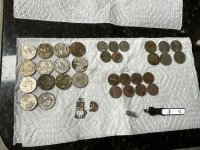Hward56
Jr. Member
- Jan 26, 2017
- 43
- 181
- Detector(s) used
- Garrett AT Pro, Tesoro Sabre
- Primary Interest:
- All Treasure Hunting
Found this 1853 New York Crystal Palace...H.B. West...Tray & Troy...souvenir token at my special permit antebellum home in St Francisville, La.
The plantation is rich in history going back to the late 1700's...
On a side note...I thought i actually had dug a gold coin due to its coloring...
AT Pro is my go-to machine...
The plantation is rich in history going back to the late 1700's...
On a side note...I thought i actually had dug a gold coin due to its coloring...
AT Pro is my go-to machine...
Attachments
Upvote
34











